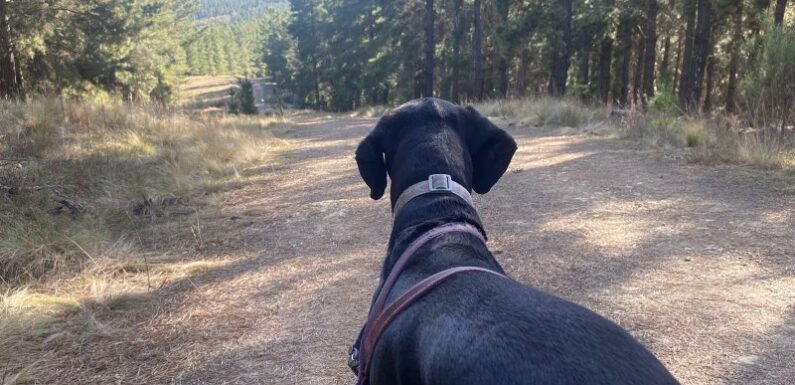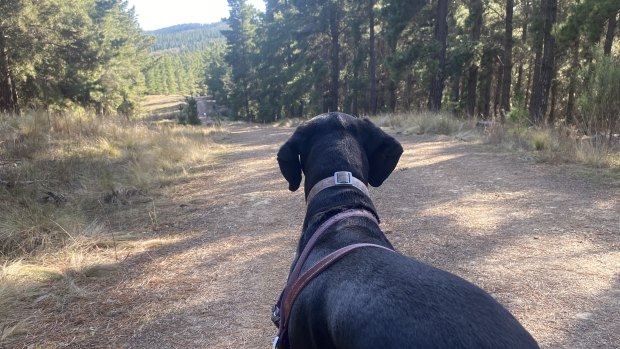
Save articles for later
Add articles to your saved list and come back to them any time.
I love my dog.
An all-black German short-haired pointer, Scully is well known around my neighbourhood (and at the local Parkrun), as we are often out and about on our daily run. We’ve pounded pavements, run up nearby mountains and hit the trails that dot our part of the world. All on our own dime, not asking for a handout from the federal or territory government.
Yet federal governments of both political persuasions have been throwing your money and mine into a nationwide effort to woo voters one dog park at a time. And it’s time for it to stop.
Every election, the major parties engage in a bidding war to win your electoral support. It used to be that a local road or roundabout was enough. But now political campaigns have extended their focus from humans who can vote to the dogs at their feet.
Shane Wright’s dog, Scully, enjoying a run in nature.
A decade ago, there was not a federal dollar spent on parks for dogs. They were, rightly, seen as something the local council should busy itself with – not the federal government. But somewhere along the way, some bright spark thought it would be a great use of taxpayers’ money to win over dog owners as governments sought ever more exotic ways to buy their way to victory.
Over the past four years alone, 39 separate dog park projects have either been recently constructed or are under way, to the tune of $6.3 million. Almost all of these park projects were promised by the Morrison government, but a few are being built by the Albanese government. It’s a policy that wags all political tails.
From Darwin to Tasmania, Townsville to Perth, dog parks have been built at a cost of up to $300,000 a pop. In one case, federal taxpayers shelled out $25,000 for “information on rules and regulations to dog management and providing bags for responsible dog ownership”. In non-bureaucrat jargon, that translates to a council getting federal cash to provide local dog owners with bags to pick up their dog’s turds.
But if a council can’t afford to do something as simple as stock plastic dog bags, there’s something either wrong with the council or with the amount of funding it is getting from its state government. There’s no role for federal taxpayers in cleaning up after the dogs of the nation.
Sadly, the federal cash splash doesn’t stop at the wrong end of a dog. Over in Perth, you and I have given a council $23,100 for a “drinking fountain and associated dog drinking bowl to address community need including water supply”.
Cardinia Shire, in Victoria, received $320,000 to build a fully fenced off-leash dog area that included “agility equipment, landscaping, pathways, seating and quiet dog area”.
In the northern suburbs of Melbourne, taxpayers contributed $300,000 for the upgrade of a dog park apparently to “incorporate contemporary dog park design principles which provide health and social benefits to both dogs and their owners”. The fence line was changed to get rid of right angles, drinking fountains were installed, and the surface of the park was improved to “enhance sensory interaction for dogs while a mixture of hardscape and natural elements”.
Scully gets her “enhanced sensory interaction” by walking or running along existing footpaths or the bushland trails. Sensory interaction extends to our backyard as she ambushes a bee or two.
Shane Wright and his dog, Scully, out on a run.
This wouldn’t be so serious if not for the fact that these parks are being financed by our taxes at a time when most people are struggling under the weight of high inflation, increasingly expensive mortgages and bracket creep.
There is a role for the federal government to invest in country-improving infrastructure. But when infrastructure “investment” is code for “what we’ll offer a community to win their votes”, then we’re all losers.
Last week, Infrastructure Minister Catherine King released an independent review of the 10-year, $120 billion pipeline of projects it inherited from the previous government. The review was blunt – bad decisions and bad planning meant too much had been promised, and the cost had ballooned.
That’s a pipeline of roads and railways and bridges, though. It didn’t include things couched as “community infrastructure”, which has increasingly covered everything from indoor swimming pools to CCTV protection to fences around cemeteries and dog parks.
Cemeteries have long been the responsibility of the local council and their ratepayers. But, again, the feds have come in with an open chequebook.
In 2021, the council responsible for the Nyngan cemetery in NSW received $48,415 of federal taxpayer funding because the lawn, during dry periods, is “invaded by hungry wildlife, particularly kangaroos, which cause damage to gravesites”.
Up in Queensland, a local council received $105,000 so that it could install interpretive signs and upgrade headstones that had deteriorated.
Some federal politicians justify this sort of expenditure as supporting their local community. But if that’s what they believe, perhaps they should stand for the local council because that’s who should be responsible for such projects.
Last year, the federal government collected almost $300 billion in personal income tax and another $150 billion from company tax. This is supposed to pay for federal programs like aged pension, our defence and judicial systems, and infrastructure of national importance.
Nowhere in the Constitution does it stipulate the federal government should be building dog dropping dispensers.
Even Scully knows this stupidity has to stop.
Shane Wright is a senior economics correspondent for The Age.
The Opinion newsletter is a weekly wrap of views that will challenge, champion and inform your own. Sign up here.
Most Viewed in Politics
From our partners
Source: Read Full Article

